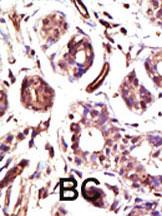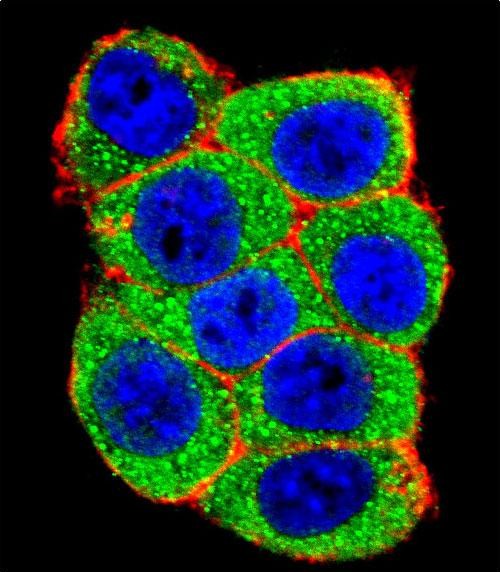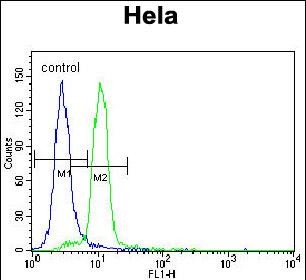UBE3A Antibody (C-term)
Purified Rabbit Polyclonal Antibody (Pab)
- 产品详情
- 文献引用 : 1
- 实验流程
- 背景知识
Application
| WB, IHC-P, IF, FC, E |
|---|---|
| Primary Accession | Q05086 |
| Reactivity | Mouse, Human |
| Host | Rabbit |
| Clonality | Polyclonal |
| Isotype | Rabbit IgG |
| Calculated MW | 100688 Da |
| Antigen Region | 836-865 aa |
| Gene ID | 7337 |
|---|---|
| Other Names | Ubiquitin-protein ligase E3A, 632-, E6AP ubiquitin-protein ligase, Human papillomavirus E6-associated protein, Oncogenic protein-associated protein E6-AP, Renal carcinoma antigen NY-REN-54, UBE3A, E6AP, EPVE6AP, HPVE6A |
| Target/Specificity | This UBE3A antibody is generated from rabbits immunized with a KLH conjugated synthetic peptide between 836-865 amino acids from the C-terminal region of human UBE3A. |
| Dilution | WB~~1:1000 IHC-P~~1:100~500 IF~~1:10~50 FC~~1:10~50 E~~Use at an assay dependent concentration. |
| Format | Purified polyclonal antibody supplied in PBS with 0.09% (W/V) sodium azide. This antibody is prepared by Saturated Ammonium Sulfate (SAS) precipitation followed by dialysis against PBS. |
| Storage | Maintain refrigerated at 2-8°C for up to 2 weeks. For long term storage store at -20°C in small aliquots to prevent freeze-thaw cycles. |
| Precautions | UBE3A Antibody (C-term) is for research use only and not for use in diagnostic or therapeutic procedures. |
| Name | UBE3A (HGNC:12496) |
|---|---|
| Function | E3 ubiquitin-protein ligase which accepts ubiquitin from an E2 ubiquitin-conjugating enzyme in the form of a thioester and transfers it to its substrates (PubMed:10373495, PubMed:16772533, PubMed:19204938, PubMed:19233847, PubMed:19325566, PubMed:19591933, PubMed:22645313, PubMed:24273172, PubMed:24728990, PubMed:30020076). Several substrates have been identified including the BMAL1, ARC, LAMTOR1, RAD23A and RAD23B, MCM7 (which is involved in DNA replication), annexin A1, the PML tumor suppressor, and the cell cycle regulator CDKN1B (PubMed:10373495, PubMed:19204938, PubMed:19325566, PubMed:19591933, PubMed:22645313, PubMed:24728990, PubMed:30020076). Additionally, may function as a cellular quality control ubiquitin ligase by helping the degradation of the cytoplasmic misfolded proteins (PubMed:19233847). Finally, UBE3A also promotes its own degradation in vivo. Plays an important role in the regulation of the circadian clock: involved in the ubiquitination of the core clock component BMAL1, leading to its proteasomal degradation (PubMed:24728990). Acts as transcriptional coactivator of progesterone receptor PGR upon progesterone hormone activation (PubMed:16772533). Acts as a regulator of synaptic development by mediating ubiquitination and degradation of ARC (By similarity). Required for synaptic remodeling in neurons by mediating ubiquitination and degradation of LAMTOR1, thereby limiting mTORC1 signaling and activity-dependent synaptic remodeling (By similarity). Synergizes with WBP2 in enhancing PGR activity (PubMed:16772533). |
| Cellular Location | Cytoplasm {ECO:0000250|UniProtKB:O08759}. Nucleus {ECO:0000250|UniProtKB:O08759} |
For Research Use Only. Not For Use In Diagnostic Procedures.

Provided below are standard protocols that you may find useful for product applications.
BACKGROUND
UBE3A interacts with the E6 protein of the cancer-associated human papillomavirus types 16 and 18. The E6/E6-AP complex binds to and targets the p53 tumor-suppressor protein for ubiquitin-mediated proteolysis. It is an E3 ubiquitin-protein ligase which accepts ubiquitin from an E2 ubiquitin-conjugating enzyme in the form of a thioester and then directly transfers the ubiquitin to targeted substrates. It can target itself for ubiquitination in vitro and efficiently promotes its own degradation in vivo. It appears that only unmodified E6-AP molecules can bind efficiently to p53 in the presence of the HPV E6 oncoprotein. UBE3A binds UBQLN1 and UBQLN2. Defects in UBE3A are a cause of Angelman syndrome (AS) [MIM:105830]; also known as 'happy puppet syndrome'. AS is characterized by features of severe motor and intellectual retardation, microcephaly, ataxia, frequent jerky limb movements and flapping of the arms and hands, hypotonia, hyperactivity, hypopigmentation, seizures, absence of speech, frequent smiling and episodes of paroxysmal laughter, and an unusual facies characterized by macrostomia, a large mandible and open-mouthed expression, a great propensity for protruding the tongue ('tongue thrusting'), and an occipital groove. UBE3A contains 1 HECT-type E3 ubiquitin-protein ligase domain.
REFERENCES
Be, X., et al., Biochemistry 40(5):1293-1299 (2001).
Kleijnen, M.F., et al., Mol. Cell 6(2):409-419 (2000).
Huang, L., et al., Science 286(5443):1321-1326 (1999).
Nuber, U., et al., Eur. J. Biochem. 254(3):643-649 (1998).
Malzac, P., et al., Am. J. Hum. Genet. 62(6):1353-1360 (1998).
终于等到您。ABCEPTA(百远生物)抗体产品。
点击下方“我要评价 ”按钮提交您的反馈信息,您的反馈和评价是我们最宝贵的财富之一,
我们将在1-3个工作日内处理您的反馈信息。
如有疑问,联系:0512-88856768 tech-china@abcepta.com.






















 癌症的基本特征包括细胞增殖、血管生成、迁移、凋亡逃避机制和细胞永生等。找到癌症发生过程中这些通路的关键标记物和对应的抗体用于检测至关重要。
癌症的基本特征包括细胞增殖、血管生成、迁移、凋亡逃避机制和细胞永生等。找到癌症发生过程中这些通路的关键标记物和对应的抗体用于检测至关重要。 为您推荐一个泛素化位点预测神器——泛素化分析工具,可以为您的蛋白的泛素化位点作出预测和评分。
为您推荐一个泛素化位点预测神器——泛素化分析工具,可以为您的蛋白的泛素化位点作出预测和评分。 细胞自噬受体图形绘图工具为你的蛋白的细胞受体结合位点作出预测和评分,识别结合到自噬通路中的蛋白是非常重要的,便于让我们理解自噬在正常生理、病理过程中的作用,如发育、细胞分化、神经退化性疾病、压力条件下、感染和癌症。
细胞自噬受体图形绘图工具为你的蛋白的细胞受体结合位点作出预测和评分,识别结合到自噬通路中的蛋白是非常重要的,便于让我们理解自噬在正常生理、病理过程中的作用,如发育、细胞分化、神经退化性疾病、压力条件下、感染和癌症。









